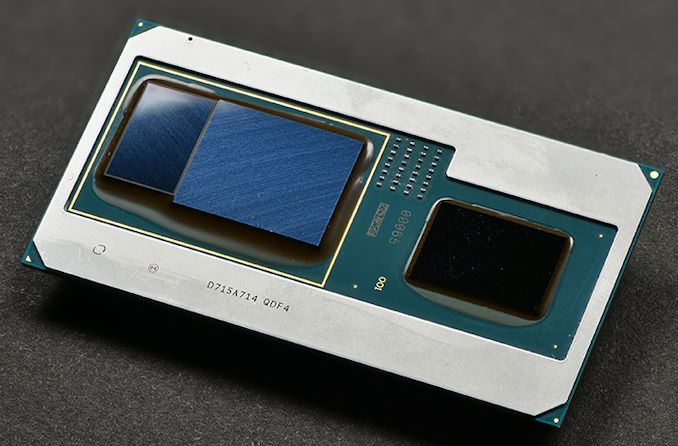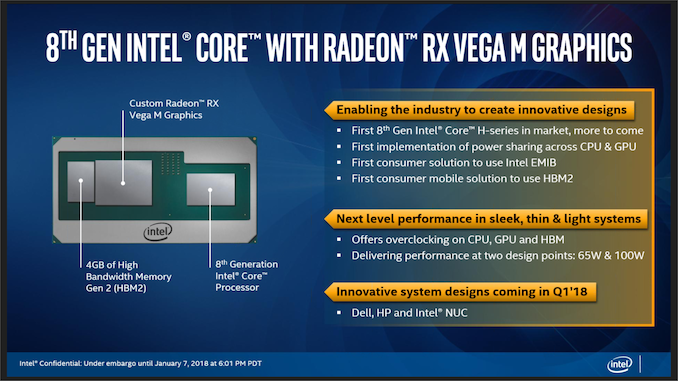Intel Kaby Lake-G GPU Driver Updates Left In Limbo, Currently Unsupported
by Ryan Smith on June 8, 2020 12:00 PM EST
While the retail shelf life of Intel’s unusual Kaby Lake-G processor has pretty much passed at this point, it looks like it has become the gift that keeps on giving when it comes to confusion about how support for the combined Intel/AMD chip will work. First spotted by Tom’s Hardware, AMD’s latest driver Radeon driver installer doesn’t include support for the chip’s AMD “Vega M” GPU, and as a result there are currently no up-to-date drivers available for the platform. And while Tom’s Hardware did get a cryptic-but-promising response from AMD about future driver support, for the moment it’s not clear what’s going to happen or how long-term driver support for the processor will work.
A one-off collaboration between Intel and AMD, Intel’s Kaby Lake-G processor combined a quad-core Intel Kaby Lake CPU with a discrete AMD Polaris-based GPU, all on a single package. With the AMD dGPU covering for Intel’s traditionally weak integrated graphics, Kaby Lake-G gave Intel and interesting chip that could deliver great compute performance and much stronger graphics performance as well.
However since the GPU portion of Kaby Lake-G came from outside Intel, the chip has always existed in an odd place where it’s never been fully embraced by either manufacturer. Even as an Intel-sold and Intel-branded product, Kaby Lake-G’s Radeon roots were never really hidden, and indeed the chip’s GPU drivers have clearly been a derivative of AMD’s standard driver set since the very beginning. But this has also meant that Intel has been reliant on AMD to provide those drivers, and for reasons that are not entirely public or transparent, this hasn’t been handled well. After a very long break between GPU driver updates, Intel essentially gave up on putting any kind of façade on the source of their GPU drivers, and began directing users to install AMD’s Radeon drivers, which at the same time gained official support for the chip.
And that was the end of that. Or so we thought.
Instead, as spotted by the Tom’s Hardware crew, Kaby Lake-G support has once again gone missing from AMD’s drivers. As a result, it’s not possible to install current drivers for the hardware – and even finding drivers that can be installed is a bit of an easter egg hunt.
When they reached out to Intel about the matter – and specifically, about updated drivers for Hades Canyon, Intel’s Kaby Lake-G based NUC – Tom’s Hardware did get a promising, but nonetheless cryptic response from the chipmaker:
And for the moment, this is where things stand, with no official explanation as to what’s going on. Driver support for Kaby Lake-G hangs in limbo, as Intel and AMD seem to be unable to sort out responsibility for the chip.
Joint projects like these are some of the most difficult in the industry, as having multiple vendors involved in a single product means that there’s some degree of cooperation required. Which is easier said than done when it involves historic rivals like Intel and AMD. Still, I would have expected that driver support is something that would have been hammered out in a contract early on – such that AMD was committed to deliver and paid for the necessary 5 years of drivers – rather than the current situation of Intel and AMD seemingly dancing around the issue.
In the meantime, here’s to hoping that Kaby Lake-G’s driver situation gets a happier ending in due time.
Source: Tom's Hardware











46 Comments
View All Comments
lightningz71 - Monday, June 8, 2020 - link
This one I place SQUARELY on Intel as they have an established track record of doing this very same thing in the past:Witness some of their Atom N series CPUs as implemented in the Acer Aspire One series, integrating Intel Atom cores with an iGPU developed from PowerVR IP. Intel contracted PowerVR to supply an initial, operational driver and for a period to supply bug fixes for that one driver. After that initial period of bug fixes was over, complete radio silence! Intel hasn't done a thing to ever touch those drivers again. While the launch drivers mostly work for Windows 7, anything later is relegated to the windows default svga driver, which lacks almost any real acceleration.
PowerVR, when contacted directly, points you to Intel as they own the product and are responsible for its support. Intel points you to PowerVR, stating that the IP in the chip belongs to PowerVR and that, without the contract, they can't (won't) touch it. The core of the issue is that Intel chose to do the absolute bare minimum to get the chip out the door while it was being produced, and then immediately dropped it like a sack of burning animal excrement (which, to be fair, it is). Because they chose not to continue to pay PowerVR to produce driver updates, like, for example, Windows 8, which was released while the laptops that contained the chip were still in retail, PowerVR wasn't going to be a charity for Intel and produce them for free.
What I find most disappointing about this when I look at AMD is that, the chip itself hasn't changed. Its based on a slightly modified version of Polaris, which is still receiving driver updates on the regular. At the VERY least, they could just include a final driver for it in subsequent releases and have it in the release notes that support for that product is feature and maintenance frozen at a certain date. However, there MAY be wording, somewhere deep in the contracts for the driver package, that specifically forbids AMD from doing so in a "planned obsolescence" sort of strategy.
I bet certain OEMs are a bit upset about this though. I believe that some of those processors went into "long life" corporate SKUs that are required to have support for X number of years. That could throw a wrinkle into this one...
diehardmacfan - Monday, June 8, 2020 - link
Dell is still actively selling the XPS 15 2-in-1 with this in it. I'm sure they aren't moving a ton of those units but I'm sure they aren't happy about it.MenhirMike - Monday, June 8, 2020 - link
I know this is as much on Intel as it's on AMD, but: AMD's graphics driver situation is a trainwreck. Always has been, and likely every will be. At least they've started supporting Ryzen Mobile with drivers a while ago, after not caring for the first year of its existence. But as far as I am concerned, I've regretted buying AMD graphics every single time I did it, all the way back to when it was still ATI before the acquisition. And it was never a hardware issue, the hardware is awesome, has great performance and price/performance ratio, but the drivers are trash :(DigitalFreak - Monday, June 8, 2020 - link
AMD/ATI have always had crap drivers. AMD's takeover certainly didn't change that.Deicidium369 - Monday, June 8, 2020 - link
Way back in ATI's time - all driver sucked - especially when you tried to install and use themFXi - Monday, June 8, 2020 - link
Despite their well earned success in recent years this kind of behavior has repeatedly put me off their products. Customers don't get to find out for a couple of years after they have laid down their money whether AMD will deem their product worthy of support. And this has happened repeatedly over many decades and is disassociated with the current fiscal success or not of AMD the company. Fact is you are almost always taking a chance that after some period of time in which you, the consumer are still happily using the product, that it will go unsupported. So AMD can happily wave all those performance numbers they want. But we already have seen supported/unsupported issues with what their chipsets will support for cpu's. Sometimes driver fixes take the better part of a year to fix. And all that puts a serious damper on performance advantages or price advantages when a consumer comes to buy. If they really want to be at the top of the market they have to do much more than simply offer a performing product. Support problems like this need to stop, entirely. You ruin customer trust every time you stop something. And that will, long term, keep AMD from market positions they could have simply because of their own failure.GreenReaper - Monday, June 8, 2020 - link
That's great, except it's ultimately an Intel product. They sold it, so they (or as people bought it as part of a system, the manufacturer of the product it's in) are responsible for support, just like Microsoft is responsible for support of the Xbox which has both AMD graphics *and* CPU cores. According to PCWorld Intel are supporting it five years from release. Chips were sold on that basis. The fact that they're discontinuing sales at the end of the month shouldn't change that - and as a practical matter they've released drivers for HD4000 graphics components all the way to this year.TEAMSWITCHER - Monday, June 8, 2020 - link
I don't think this is an Intel thing. Tht BootCamp drivers for my MacBook Pro 16" haven't been updated since it was introduced last November, and AMD still has thesw old drivers on their website. AMD loves to score these design wins for the janky platforms and then ignore them. AMD just isn't good at drivers.eastcoast_pete - Monday, June 8, 2020 - link
I guess that "one off" design has just gotten the support f-off. Really classy, AMD and Intel! Glad I didn't buy one, but this is not okay!Deicidium369 - Monday, June 8, 2020 - link
I can see Intel not wanting to deal with it - they are not going to develop drivers for AMD's GPU - but AMD not making something available for a product they sold is bad - wouldn't take much for the Night Janitor / Head of AMD Software to make a few changes for the sake of their customers - and then put it on EOL time line and forget about it